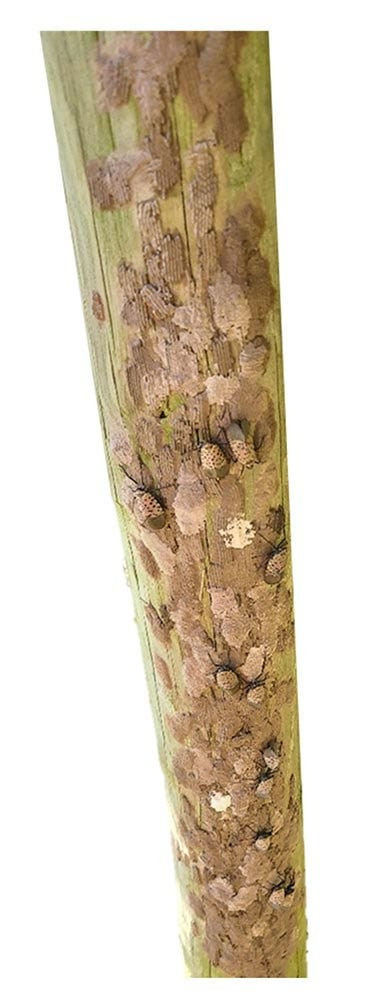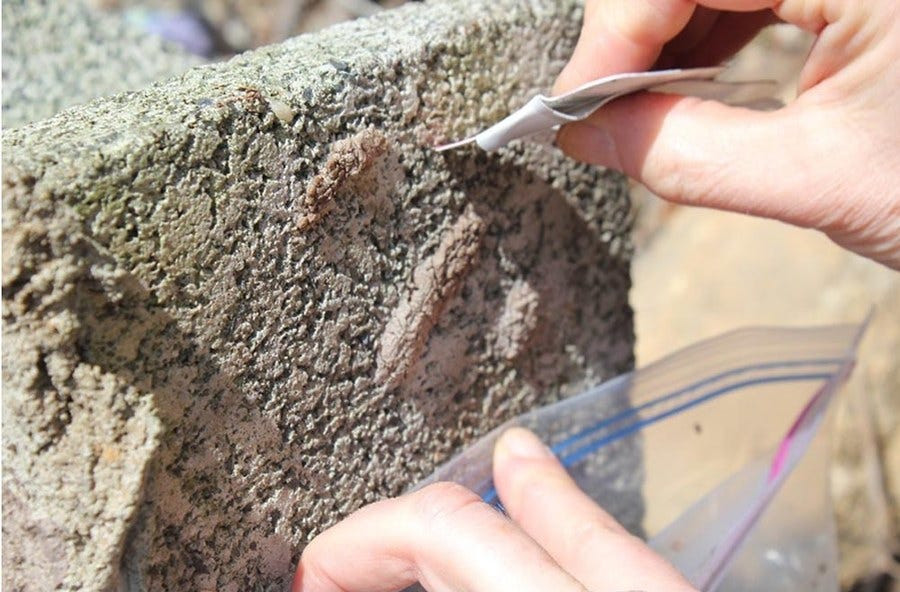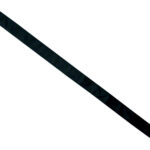Do you want to know when lantern flies lay their eggs? Spotted lanternflies typically lay their eggs from late summer into early winter, with the peak laying period usually occurring in October. Flyermedia.net is your go-to resource for understanding the spotted lanternfly’s life cycle and effective control strategies, helping you protect your property and the environment with timely information on pest management and agricultural insights. Explore effective lanternfly control strategies, including tree trapping, nymph and adult management, and ovicides.
1. Identifying Spotted Lanternfly Egg Masses
Spotted lanternfly (SLF) egg masses, crucial for understanding their life cycle, generally appear from late summer to early winter. These egg masses are typically about 1.5 inches long and exhibit a brown/grey coloration, although variations can occur. Recognizing these egg masses is the first step in controlling the spread of this invasive species.
1.1 What Do Spotted Lanternfly Egg Masses Look Like?
SLF egg masses consist of rows of small eggs, each roughly the size of a sharpened pencil point. According to research from Penn State Extension, the color of these eggs can vary from yellow to brown. After laying, the female covers the eggs with a protective substance that initially appears white and glossy, but dries to a darker grey/brown color within a few hours.
 Variations in spotted lanternfly egg masses
Variations in spotted lanternfly egg masses
Variations in spotted lanternfly egg masses including color (yellow, gray, brown) and covering. Photo Heather Leach.
1.2 What If an Egg Mass Doesn’t Have a Covering?
Sometimes, SLF egg masses lack the protective covering, often due to disturbances during the laying process. According to Penn State Extension research, these uncovered egg masses can still hatch, although they typically have a 10% lower hatch rate compared to covered ones. It is essential to remove and destroy all egg masses, regardless of whether they have a covering.
1.3 How Can You Tell the Difference Between a New and Old Egg Mass?
Distinguishing between new and old egg masses is crucial for effective control. Fresh egg masses will have a covering on top, while older ones may have a faded, dry, and cracked covering. After the eggs hatch, the covering often disappears altogether. Additionally, old egg masses will have emergence holes, which are perfect oval openings where nymphs have escaped, according to Penn State Extension.
2. Where Do Lanternflies Lay Their Eggs?
Spotted lanternflies exhibit specific preferences for egg-laying sites. Understanding these preferences can help you target your search and removal efforts more effectively.
2.1 Where Do Female Lanternflies Prefer to Lay Their Eggs?
Female SLF typically lay their eggs on trees near their feeding sites. According to research from Penn State Extension, they often choose red maple, silver maple, and willows as host trees in the late season. However, they may also lay eggs on trees they do not heavily feed on, such as black cherry and pine trees.
2.2 Do Lanternflies Lay Eggs in Specific Areas?
SLF prefer to lay egg masses in protected areas such as the undersides of tree limbs, picnic tables, and other outdoor surfaces that are horizontal or angled toward the ground. According to studies by Penn State Extension, females often lay eggs near other SLF egg masses, resulting in clustered egg masses.
 A wooden post abundant with spotted lanternfly egg masses
A wooden post abundant with spotted lanternfly egg masses
A wooden post abundant with spotted lanternfly egg masses. Spotted lanternfly females prefer to lay eggs next to already existing egg masses. Photo Heather Leach.
2.3 How High Up Do Lanternflies Lay Their Eggs?
It’s important to note that many egg masses are laid at unreachable heights. According to research from Penn State Extension, less than 2% of egg masses on a tree are within a reachable distance (0-10 feet). This means that the majority of egg masses are above reach. It is not recommended to use ladders or climb trees to reach these egg masses.
3. Reporting and Removing Spotted Lanternfly Egg Masses
Reporting and removing SLF egg masses is a crucial step in controlling their spread. Knowing when and how to report and remove these egg masses can significantly impact your local SLF population.
3.1 When Should You Report Spotted Lanternfly Egg Masses?
If you find SLF egg masses outside of the quarantine zone, it should be reported immediately and destroyed. If you are within most areas of the current quarantine zone, egg masses do not need to be reported, according to the Penn State Extension. However, if you find an egg mass within quarantined counties newly added in 2020 (Beaver, Allegheny, Blair, Huntingdon, Mifflin, Juniata, Perry, Cumberland, York, Northumberland, Columbia, and Luzerne), it is helpful to management and monitoring efforts if you destroy and report these.
3.2 How Do You Report Spotted Lanternfly Egg Masses?
To report your findings, you can visit the Penn State Extension Spotted Lanternfly website or call their hotline at 1-888-422-3359. Taking a picture of the egg mass before destroying it can help officials confirm the sighting.
3.3 How Do You Scrape or Smash Spotted Lanternfly Egg Masses?
If you find egg masses on your property from September to May, you can scrape them off using a plastic card or putty knife. According to Penn State Extension, scrape the egg masses into a bag or container filled with rubbing alcohol or hand sanitizer and keep them in this solution permanently. Egg masses that are scraped to the ground can still hatch, so it is important to follow all steps! Egg masses can also be smashed, but be sure to apply even and forceful pressure to the entire egg mass. A properly smashed egg will burst open.
 Scraping spotted lanternfly egg masses into a plastic bag from a cinder block
Scraping spotted lanternfly egg masses into a plastic bag from a cinder block
Scraping spotted lanternfly egg masses into a plastic bag from a cinder block. Photo Nancy Bosold.
3.4 What Are Ovicides and How Do They Work on Egg Masses?
Ovicides are insecticides that have ovicidal action against SLF eggs. According to studies done in 2018 and 2019, paraffinic and/or mineral oils such as JMS Stylet oil, Damoil, and Lesco Horticultural oil are effective products. These oils, commonly used in fruit systems, can control soft-bodied insects. When applied at a solution of at least 3 percent, they were effective in killing up to 75 percent of treated eggs, according to Penn State Extension research.
4. The Spotted Lanternfly Life Cycle
Understanding the spotted lanternfly’s life cycle is key to implementing effective control measures. Each stage presents unique challenges and opportunities for intervention.
4.1 What is the Life Cycle of the Spotted Lanternfly?
The SLF has several life stages: egg, nymph, and adult. Eggs are laid from late summer to early winter and hatch in the spring. Nymphs go through four instars, feeding on various host plants. Adults emerge in late summer and continue to feed and reproduce until the first hard frost. According to the Pennsylvania Department of Agriculture, understanding this cycle is crucial for targeted control strategies.
4.2 What Happens After the Eggs Hatch?
After the eggs hatch in the spring, nymphs emerge and begin feeding on host plants. These nymphs go through four developmental stages, each requiring different management strategies. According to research from Penn State Extension, nymphs are most vulnerable during their early instars, making targeted insecticide applications effective.
4.3 How Does the Weather Affect Egg Hatching?
Weather conditions significantly impact the hatching of SLF eggs. Warmer temperatures can accelerate the hatching process, while colder temperatures can delay it. According to a study by the USDA, consistent monitoring of temperature fluctuations can help predict hatch times and optimize control efforts.
5. Effective Spotted Lanternfly Control Strategies
Combating the spotted lanternfly requires a multi-faceted approach. Combining various control methods can help minimize their impact on your property and the environment.
5.1 What Are Some Preventative Measures to Control Spotted Lanternflies?
Preventative measures include inspecting outdoor items for egg masses, removing host trees, and using tree bands to trap nymphs. According to the New Jersey Department of Agriculture, these measures can significantly reduce the SLF population in your area.
5.2 What Are the Best Insecticides to Use Against Spotted Lanternflies?
Insecticides can be effective against SLF nymphs and adults. According to research from Penn State Extension, systemic insecticides applied to host trees can kill SLF as they feed. Contact insecticides can also be used to target nymphs and adults directly. Always follow label instructions and safety precautions when using insecticides.
5.3 How Do Tree Traps Work?
Tree traps are designed to capture SLF nymphs and adults as they climb trees to feed. According to the Pennsylvania Department of Agriculture, sticky bands and circle traps are common types of tree traps. These traps can help reduce the SLF population, but should be monitored regularly to avoid trapping non-target species.
5.4 Can Biological Control Methods Be Used to Manage Spotted Lanternflies?
Research into biological control methods, such as natural predators and pathogens, is ongoing. According to the USDA, scientists are exploring the potential of using native and imported natural enemies to control SLF populations. While biological control methods are not yet widely available, they offer a promising long-term solution.
6. Spotted Lanternfly Quarantine Zones
Quarantine zones are established to prevent the spread of SLF to new areas. Understanding these zones and their regulations is crucial for compliance and effective control.
6.1 What is a Spotted Lanternfly Quarantine Zone?
A quarantine zone is a designated area where SLF has been identified. The purpose of the quarantine is to prevent the movement of SLF to uninfested areas. According to the Pennsylvania Department of Agriculture, these zones are established to contain the spread of SLF and protect agricultural resources.
6.2 What Are the Regulations Within a Quarantine Zone?
Within a quarantine zone, there are specific regulations to prevent the spread of SLF. These regulations may include restrictions on the movement of plants, outdoor equipment, and other items that could harbor SLF. According to the Pennsylvania Department of Agriculture, businesses operating within a quarantine zone may need to obtain a permit and complete training to ensure compliance.
6.3 How Can You Comply with Quarantine Regulations?
To comply with quarantine regulations, inspect all items for SLF before moving them out of the quarantine zone. Remove any SLF or egg masses found. If you are a business operating within a quarantine zone, obtain the required permit and training from the Pennsylvania Department of Agriculture.
7. The Impact of Spotted Lanternflies on Agriculture and the Environment
The spotted lanternfly poses a significant threat to agriculture and the environment. Understanding its impact can help you appreciate the importance of control efforts.
7.1 How Do Spotted Lanternflies Damage Plants?
SLF feed on the sap of plants, which can weaken them and make them more susceptible to disease and other pests. According to Penn State Extension, heavy infestations can kill young trees and reduce crop yields.
7.2 What Crops Are Most Affected by Spotted Lanternflies?
SLF feed on a wide range of plants, including grapes, apples, peaches, and hops. According to the Pennsylvania Department of Agriculture, these crops are particularly vulnerable to SLF damage.
7.3 How Do Spotted Lanternflies Affect the Environment?
In addition to direct damage to plants, SLF can also disrupt ecosystems. Their feeding activity can alter plant communities and affect wildlife that depend on those plants. According to the USDA, SLF can also produce honeydew, which can promote the growth of sooty mold and attract other pests.
8. Resources for Staying Informed About Spotted Lanternflies
Staying informed about SLF is crucial for effective control. Numerous resources are available to provide you with the latest information and guidance.
8.1 What Are Some Reliable Sources of Information About Spotted Lanternflies?
Reliable sources of information about SLF include Penn State Extension, the Pennsylvania Department of Agriculture, the USDA, and other state and federal agencies. These organizations provide research-based information on SLF biology, management, and quarantine regulations.
8.2 How Can You Stay Up-To-Date on Spotted Lanternfly News?
You can stay up-to-date on SLF news by subscribing to email alerts from Penn State Extension and other organizations. You can also follow these organizations on social media and check their websites regularly for updates.
8.3 Where Can You Find Educational Materials About Spotted Lanternflies?
Educational materials about SLF are available on the websites of Penn State Extension, the Pennsylvania Department of Agriculture, and other organizations. These materials include fact sheets, videos, and interactive tools.
9. Spotted Lanternfly Look-Alikes
It’s important to accurately identify SLF to avoid misidentifying other insects. Familiarizing yourself with SLF look-alikes can help you target your control efforts effectively.
9.1 What Insects Are Commonly Mistaken for Spotted Lanternflies?
Some insects that are commonly mistaken for SLF include the ailanthus webworm, the boxelder bug, and certain types of moths. According to Penn State Extension, it’s important to look for the distinctive markings of SLF to avoid misidentification.
9.2 How Can You Tell the Difference Between a Spotted Lanternfly and a Look-Alike?
SLF have distinctive markings that can help you distinguish them from look-alikes. Adult SLF have grey wings with black spots, and a red underwing with black and white markings. Nymphs have black bodies with white spots, and develop red patches as they mature. According to Penn State Extension, these markings are unique to SLF and can help you accurately identify them.
9.3 What Should You Do If You’re Not Sure If You’ve Found a Spotted Lanternfly?
If you’re not sure if you’ve found a SLF, take a picture and submit it to Penn State Extension or your local extension office for identification. They can help you determine if you’ve found a SLF and provide guidance on control measures.
10. Community Involvement in Spotted Lanternfly Control
Controlling SLF requires a community-wide effort. Getting involved in local initiatives can help you make a difference in your area.
10.1 How Can You Get Involved in Spotted Lanternfly Control Efforts in Your Community?
You can get involved in SLF control efforts in your community by participating in volunteer programs, reporting SLF sightings, and educating your neighbors about SLF. According to the Pennsylvania Department of Agriculture, community involvement is crucial for effective SLF control.
10.2 What Are Some Examples of Community-Based Spotted Lanternfly Control Programs?
Some examples of community-based SLF control programs include egg mass scraping events, tree banding initiatives, and educational workshops. These programs provide opportunities for community members to work together to control SLF populations.
10.3 How Can You Educate Others About Spotted Lanternflies?
You can educate others about SLF by sharing information from reliable sources, such as Penn State Extension and the Pennsylvania Department of Agriculture. You can also organize educational workshops and distribute fact sheets to your neighbors.
By understanding the life cycle, identifying egg masses, and implementing effective control strategies, you can help protect your property and community from the spotted lanternfly. Remember to stay informed, get involved, and work together to combat this invasive species. And for more information, insights, and resources, visit flyermedia.net – your trusted source for all things aviation and beyond. Discover opportunities in aviation education, stay updated with the latest news, and explore career paths that can take you to new heights!
Are you facing challenges in finding a suitable flight training school, understanding aviation regulations, or staying updated with the latest industry news? At flyermedia.net, we provide a comprehensive listing and evaluation of top flight training schools in the USA. We also simplify complex aviation regulations and deliver the latest industry news from around the globe. Additionally, we offer resources for job opportunities in the aviation sector, airline comparisons, and travel tips. Contact us at Address: 600 S Clyde Morris Blvd, Daytona Beach, FL 32114, United States. Phone: +1 (386) 226-6000. Website: flyermedia.net.
FAQ: Frequently Asked Questions About Spotted Lanternflies and Their Eggs
- When do spotted lanternflies lay their eggs? Spotted lanternflies typically lay their eggs from late summer into early winter, with October being the peak month for egg-laying activity.
- What do spotted lanternfly egg masses look like? SLF egg masses are about 1.5 inches long and are colored brown/grey. They contain rows of small eggs, roughly the size of a sharpened pencil point, covered with a protective substance.
- Where do spotted lanternflies lay their eggs? Female SLF prefer to lay eggs on trees near their feeding sites, as well as on protected surfaces like the undersides of tree limbs, picnic tables, and outdoor furniture.
- How can you tell the difference between a new and old egg mass? New egg masses have a fresh, intact covering, while older egg masses may have a faded, cracked, or missing covering. Old egg masses also have emergence holes where nymphs have hatched.
- Do spotted lanternfly egg masses always have a covering? No, some egg masses may not have a covering, often due to disturbances during the laying process. However, these uncovered egg masses can still hatch.
- What should you do if you find a spotted lanternfly egg mass? If you find an egg mass, scrape it off using a plastic card or putty knife and dispose of it in a bag or container filled with rubbing alcohol or hand sanitizer.
- Are there any insecticides that can kill spotted lanternfly eggs? Yes, paraffinic and mineral oils, such as JMS Stylet oil, Damoil, and Lesco Horticultural oil, can be effective in killing SLF eggs when applied directly to the egg masses.
- Do you need to report spotted lanternfly egg masses? If you find SLF egg masses outside of the quarantine zone, report it immediately. If you are within most areas of the current quarantine zone, egg masses do not need to be reported
- How high up do spotted lanternflies lay their eggs? Spotted lanternflies can lay eggs at various heights, but most egg masses are laid at unreachable heights (above 10 feet).
- What is the quarantine zone for spotted lanternflies? A quarantine zone is a designated area where SLF has been identified. Regulations within the zone aim to prevent the movement of SLF to uninfested areas.
